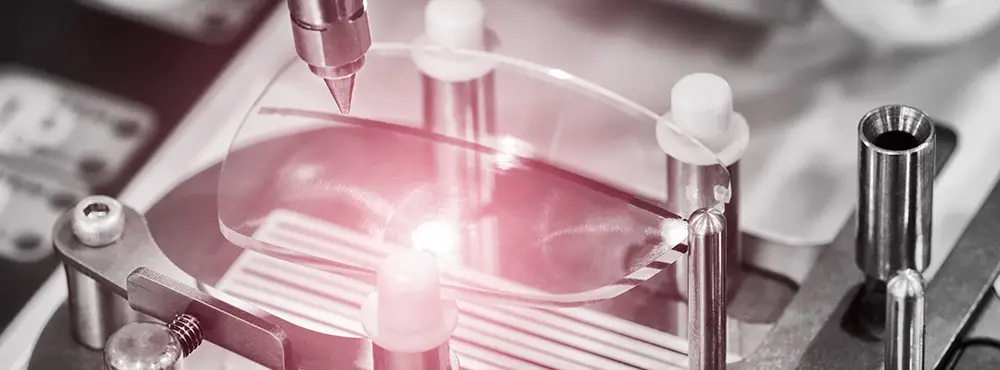We often take the most basic things we enjoy for granted. We are able to enjoy improved vision through wearing glasses today because of the innovation of others throughout history. Some of the first spectacles were simply glass magnifiers that were held by hand.
While glass was once used to manufacture lenses and metal was mostly used for frames, materials that are lighter, more versatile and easier to work with now mean that the glasses manufacturing process is now faster, cheaper and can be automated. Bone, ivory, leather and even tortoise shells were once commonly used to make frames to house lenses.
The glasses manufacturing process may need human hands at specific points but much more of it is now automated, meaning your glasses can be manufactured and sent to you a lot faster.
What is the origin of glasses?
Glasses are believed to have originated from Italy and were first seen during the 13th century. They were mostly worn by monks and gradually became more popular as the technology improved during the Renaissance.
Who invented glasses?
Salvino D’Armate and Allesandro della Spina, an Italian monk are often credited for inventing glasses in around 1285, however, many people believe that glasses had an earlier origin.
What are glasses made out of?
Most glasses frames are either made of a plastic or metal material. Plastic glasses are usually made of zyl (also known as zylonite, acetate and cellulose acetate). Plastic glasses frames can also be made from polyamide, nylon, polycarbonate, carbon and Optyl. Metal glasses are made out of monel, titanium, stainless steel, flexon or beryllium.
How are glasses frames made?
Most plastic frames are made from acetate. Acetate is light, durable and is derived from bioplastic cellulose acetate. This is a natural material compound that is extracted from the fibres of cotton balls or wood pulp.
The cellulose acetate goes through several processes, including organic synthesis, where the purified cellulose is mixed with acetic acid. This creates the compound we then call 'cellulose acetate'.
In this phase, the cellulose acetate is easy to manipulate, and dyes can be added to the compound depending on the end desired style and the cellulose acetate is then cut into thin sheets of acetate. This process is also known as routing.
The front of the lenses are cut from the acetate using machinery, although in some cases, some handy work is done. The process includes heating to create the curvature of the frames so that the lenses can sit comfortably.
A metal rod is sometimes inserted into the core of the temple for reinforcement. You can sometimes see the core if the frames have some level of transparency.
How long do glasses frames take to be made?
The time taken to make a pair of glasses depends on the volume of production. Making a large volume of glasses is done by batch production and is much quicker than making a small volume or handmade frames.
Where are glasses manufactured?
The majority of glasses are manufactured in Europe and Asia. They are mass produced using a range of processes including manual , semi-automatic and automatic production processes.
How are glasses made to a prescription?
Modern-day lenses for glasses are made to a prescription using a mixture of science, technology and art. The varying prescriptions and frame sizes means every lens has a different curvature.
1. Preparation
To start with the laboratory technician will enter the optical prescription of a pair of glasses on a computer which then prints out a copy of any additional information required in the manufacturing process of these lenses.
The technician then selects a plastic lens blank suitable for the prescription and places it in a prescription tray with the frames and the customers order.
The blanks are marked at the “optical center,” using a lensometer/focimeter. The optical center is the exact point that the patient will look through with their pupil and is the clearest part of the lens.
2. Blocking
Each lens is then covered in a protective layer to keep it from getting scratched during the grinding and blocking stage. The lens is attached to the blocker using a heated lead alloy to hold it in place during the grinding process.

3. Generating
Each lens blank is placed in a generator or grinding machine which grind the back of the lens into the correct shape.
4. Polishing
After the grinding process when the correct lens curve is generated, it is polished, bevelled and sterilsed using a variety of tools such as a fining (hand polisher) machine and soft sandpaper. During this process, the optical properties do not change. Modern machines have an auto-polisher integrated eliminating the need for a separate fining machine.
5. Edging/ Glazing and Assembly
An edge grinder grinds each lens into the final shape and puts a bevel on the edge so that it fits perfectly into the frame. A lab technician will then fit and assemble the lenses into the frame by hand.

6. Coating and tinting
This is the final stage in which the lenses are dipped in UV treatment and given a tint if desired before being placed in the customer’s frames.
Common treatments include ultra-violent tints, scratch-resistant and reactive coatings such as a photochromic coating which causes the lens to darken when activated by UV light.
7. Quality control
To ensure that each lens meets the strict quality control guidelines at Feel good Contacts, they are given a thorough inspection before delivery. Not only will a visual inspection be carried out to check for dust or damage, but a mechanical inspection will also be performed to check that each lens meets the correct specifications. During the quality control process both frames and lenses are checked.

Disclaimer: The advice in this article is for informational purposes only and does not replace medical care or an in-person check-up. Please check with an eyecare professional before purchasing any products or remedies. For information on our article review process, please refer to our Editorial Policy.

 Offers
Offers Account
Account
 Favorite
Favorite
 Basket
Basket

 OFFERS
OFFERS



















